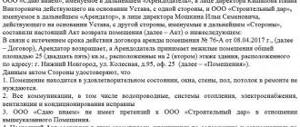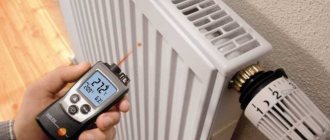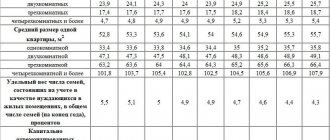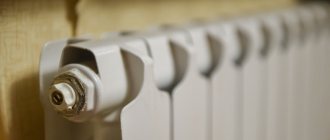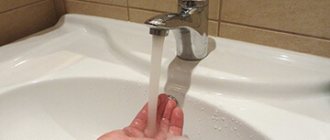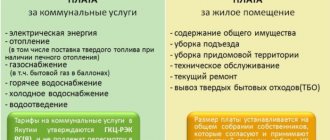Housing and communal services enterprises are obliged to provide comfortable conditions in apartments, so in winter the home should be warm. Management companies do not always ensure the prescribed temperature conditions in the premises. As a result, residents of apartment buildings not only freeze, but are also forced to overpay for services of inadequate quality.
Let's look at ways to influence the management company.
Current standards for permissible temperature in the home
Requirements for temperature conditions in housing are established in GOST R 51617-2000. This document provides differentiated indicators, taking into account the season and purpose of the premises in the apartment. permissible temperature in an apartment during the heating season is in the range from 18 to 25 degrees.
The following indicators have been established for individual parts of apartments and common areas:
Did you know
In addition to the temperature in the apartment, the legislator has determined hot water standards - they depend on the type of water supply. With an open system - in the range from 60 to 75 degrees; when closed - from 50 to 75. Read more about this in the article here
- for a living room from 18 to 24 degrees;
- for the bathroom at least 24 - 26 degrees;
- for the kitchen from 18 to 19 degrees (this is explained by the heating devices located on it);
- for children's rooms the norm is from 21 to 24 degrees (a higher temperature is optimal for infants, and closer to the lower limit for older children);
- for other rooms in the apartment the norm is within 18 – 22 degrees;
- for landings from 14 to 20 degrees;
- for the corridor between apartments from 16 to 22 degrees.
The air temperature in the apartment can deviate from the norm by no more than 3 degrees. For living rooms, discrepancies are only allowed from midnight to 5 am.
If the apartment is corner, then the minimum temperature level increases by 2 degrees, since the room has 2 walls facing the street.
Checking the water temperature in the batteries
A low level of air heating leads to a logical conclusion about insufficient heating of the coolant. To confirm your fears, you need to measure:
- indoor air;
- pipes;
- coolant.
The main difficulty arises when measuring the coolant. It is produced according to the following scheme:
- draw water from the coolant using a special tap located on the radiator;
- Place a thermometer and wait for the result.
You must act carefully. There's no need to rush. You might get scalded. In addition, it is recommended to conduct the event in the absence of small children and pets.
The indicator must comply with current standards. Deviation is acceptable. It is 4 degrees. The presence of air in the heating radiators requires immediate contact with a service company.
There is an alternative way. It is suitable for those who do not have a tap on the radiator. The DHW temperature indicators are related to a similar parameter of the heating system coolant, so it is enough to draw water from a hot tap and place a thermometer in the center of the container for 3 minutes without closing the tap.
An indicator from 60 to 70 degrees Celsius indicates compliance with the norm. If it is lower, it means the coolant is not heated enough.
Battery operating parameters and procedure for measuring their temperature
To determine compliance with the legally permissible temperature in the apartment during winter, it is necessary to check the operation of the batteries. They should be periodically monitored to establish the validity of housing and communal services tariffs.
Standards for water pressure (pressure) in an apartment are defined within the following limits:
- for cold water - from 0.3 to 6 atmospheres;
- for hot – from 0.3 to 4.5 atmospheres.
Read more on our website here.
There are no standards regulating the minimum temperature of radiators. In this case, the maximum limit for heating batteries is set, defined in SNiP 41-01-2003.
- If the heating system is two-pipe, then the radiator should not heat up above 95 degrees.
- When the system is single pipe, the limit is 115 degrees.
The recommended range is also set - from 85 to 90 degrees.
To establish deviations from the permissible temperature norm and achieve recalculation, it is necessary to measure the temperature of the radiators using one of the following methods:
- by applying a standard electronic thermometer to the surface of the battery (in this case it is necessary to add no more than 2 degrees to the readings);
- using a heat meter that senses infrared radiation;
- using an alcohol-type thermometer (it must be isolated from the environment when taking measurements).
Any of the devices used must have a certificate and passport, which contains the rules of use and error characteristics.
What is the average temperature in a heating radiator?
The temperature of water in coolants depends on weather conditions and the condition of city heating networks. This indicator rarely exceeds 90 °C. Even such a high temperature is not always enough during severe frosts. On average, the temperature of hot water in the tap and in the radiator reaches 60 °C.
You can find out the temperature using a regular mercury thermometer, which is placed in a small container and filled with water. Permissible deviations in should not exceed 4 °C, and only upward.
There are several ways to measure the temperature in the battery:
- place a thermometer on the radiator and add a couple of degrees to the obtained values;
- Buy an infrared thermometer, the error of which does not exceed half a degree. The thermometer is connected to the heating device using a thermocouple wire to the battery.
Measuring the temperature in the apartment
Violations can be detected by recording the temperature in the apartment. Measurements should be carried out observing a number of rules:
- It is necessary to record the temperature on a cloudy day so that the sun does not heat the air;
- if doors, windows or walls are not airtight, then it is necessary to limit the air flow;
- measurements are carried out in 2 rooms (except for apartments with a single living space);
- the temperature is fixed at a distance of at least half a meter from the outer wall and heating devices and not lower than 60 cm from the floor;
- as when establishing compliance with the permissible temperature of a battery in an apartment, you should use a certified device that has a passport.
When deviations are recorded, it is worth filing a claim with the management company. About where to write a complaint about housing and communal services - read this article https://potrebexpert.online/5639-sostavlyaem-zhalobu-na-zhkh-upravlyayushhuyu-kompaniyu-komu-zhalovatsya-kak
Watch the video about temperature standards:
Why is the temperature in a living room significantly lower than the standard?
During the cold season, residents complain about low temperatures and the appearance of fungus and mold. The main reasons for non-compliance with GOST average temperature in residential premises:
- increased heat transfer due to the formation of cold bridges, which entails an increase in costs for maintaining the standard temperature in the apartment;
- lack of required pressure and low water temperature in heating radiators;
- the presence of air pockets that prevent normal water circulation in the heating system. You can bleed air from central water heating radiators using a Mayevsky tap;
- non-compliance of housing with building codes (SNiP). Today, developers, in order to extract maximum profit, neglect the standards prescribed in technical regulations and build multi-storey buildings in the shortest possible time. According to statistics, more than half of modern new buildings were built with violations of architectural and construction design;
- significant heat loss can be caused by a malfunction of the window system and the presence of gaps between the panels. This problem is observed in houses built more than 30 years ago. It is impossible to touch the heating devices themselves, but the air in the apartment remains cool. Sometimes the problem can be solved by replacing wooden frames with plastic windows.
Advice! Sometimes heating networks continue to operate at full capacity when the temperature outside the window is above zero. If the housing maintenance service is not interested in the economical use of heat energy, then apartment owners should contact the management company. In case of inaction of the Criminal Code, it is necessary to write a complaint to the housing inspectorate and Rospotrebnadzor. I believe that these measures will help deal with unscrupulous utility companies.
Norm m2 per person in the office – Lawyer
When using a PVEM with a CRT-based VDT (without auxiliary devices - printer, scanner, etc.
), meeting the requirements of international computer safety standards, with a duration of less than 4 hours per day, a minimum area of 4.5 m2 per user workstation (adult and student of higher professional education) is allowed. 3.5.
For interior decoration of rooms where PCs are located, diffusely reflective materials with a reflectance coefficient for the ceiling of 0.7 - 0.8 should be used; for walls - 0.5 - 0.6; for the floor - 0.3 - 0.5. 3.6.
Polymer materials are used for interior decoration of premises with PCs in the presence of a sanitary and epidemiological conclusion. 3.7. Premises where workstations with PCs are located must be equipped with protective grounding (grounding) in accordance with the technical requirements for operation. 3.8.
In our country, almost a third of the population is engaged in office work.
Attention
At the same time, not all Russian citizens know that the employer is obliged to provide a minimum level of mandatory requirements for the employee’s workplace.
There is even a special standard for the area per person in an office, prescribed in the current legislation. According to the portal https://aero-city.com/rent/, based on the established rules for the design of premises and sanitary standards, a workplace in any office must meet the following parameters:
- An office employee whose work involves the use of a personal computer with a modern monitor is provided with a workplace area of at least 4.5 m*2. At the same time, the presence of additional equipment that consumes electricity and emits electromagnetic waves requires the mandatory provision of a separate area.
How many square meters per person in an office?
We are talking about a printer, a second monitor and other office equipment.
- A workplace where a computer with an outdated monitor is used must be allocated at least 6 m*2. When working on it for less than 4 hours, the specified area can be reduced to 4.5 m*2.
- For each employee in an office building, not counting a workstation equipped with a computer, an area of 4 m*2 should be allocated.
- For design bureau employees, the employer is required to allocate more than 6 m*2 of office space.
- If an employee has a disability, he is entitled to 5.65 m*2.
If the employee uses a stroller, then this figure increases to 7.65 m*2.
- The current standard of area per person in an office, stated above, applies exclusively to the workplace.
- the distance between the desks of two employees is 2 meters;
- distance between monitors – 1.2 meters;
- placement of monitors - at an angle to the window openings;
- office windows - facing north or northeast;
- the presence of high loads on the nervous system - it is necessary to have partitions between workplaces of 1.5-2 meters.
For this reason, it does not include passages between arranged tables or areas of the room occupied by furniture or equipment. In addition to the minimum recommended area standard for each employee, other nuances of creating office workspaces should be taken into account:
Compliance with the described recommendations will significantly increase the efficiency of hired personnel, which will bring financial benefits to the employer himself, despite the costs incurred to create comfortable jobs.
www.tehdoc.ru
I. General provisions and scope 1.2. Sanitary rules apply throughout the Russian Federation and establish sanitary and epidemiological requirements for personal electronic computers (PCs) and working conditions.
1.4. These Sanitary Rules define the sanitary and epidemiological requirements for: - design, construction and reconstruction of premises intended for the operation of all types of PCs, - organization of workplaces with PCs. 1.5.
The requirements of the Sanitary Rules apply to: - the conditions and organization of work with a PC; 1.7.
Responsibility for the implementation of these Sanitary Rules rests with legal entities and individual entrepreneurs carrying out: - operation of PCs, - design, construction and reconstruction of premises intended for the operation of PCs in industrial and administrative public buildings 1.9.
How many sqm do you need? m per employee?
And after every hour of work, the room should be ventilated (Sanitary and epidemiological rules and regulations SanPiN 2.2.2/2.4.1340-03 “Hygienic requirements for personal electronic computers and organization of work”; approved.
Chief State Sanitary Doctor of the Russian Federation on May 30, 2003). Some situations are not directly regulated by sanitary standards, but in practice they occur regularly.
These include, for example, malfunctioning toilets in the building.
In this case, according to Rostrud, the employee has the right to refuse work, and the employer must provide him with another job that does not threaten his health until the problem is resolved. If this is not possible, downtime is declared, and the employee can count on wages during downtime in the amount of at least 2/3 of his average salary (Article 157 of the Labor Code).
4.5 square meters. what an ideal office workspace should be like
- Labor law
- Protection of workers' rights
- Good afternoon, dear Formus residents. We decided to rent an office for 20 people with a friend. Please tell me what is the minimum number of meters needed per employee in Russia? Thanks in advance for your answers. The question is that, in my opinion, 3 square meters per workplace is enough for each employee, but I heard somewhere that there are certain standards for workplaces. So far I have found these posts on the Internet. – An important aspect is the number of square meters per employee. In accordance with sanitary labor standards and state standards, an ordinary employee needs 5-6 square meters of working space, a manager - 34 meters, a secretary - 15 square meters.
Sanpin norms for office premises area per person
Terentyev Bogdan
SanPiN protects the health of employees Sanitary standards of the Russian Federation are collected in a special code that defines optimal hygienic and health standards for various areas of human life, including employment. This is documentation related to the medical and technical fields, and at the same time legislative, and therefore mandatory. When using a PCEM with a CRT-based VDT (without auxiliary devices - printer, scanner, etc.) that meet the requirements of international computer safety standards, with an operating time of less than 4 hours per day, a minimum area of 4.5 m2 per user workstation is allowed (adults and students of higher professional education). 3.5.
Sanpin standards for office premises
Attention
- Sanpin for office workers
- Sanitary rules, norms and hygienic standards for working with office equipment
- What are the requirements for organizing employee workplaces?
- Office workplace standards
- Temperature in the workplace: Sanpin 2016
- Requirements for Sanpin office premises
- Requirements for office premises sanpin noise level
Sanpin for office workers And after every hour of work, the room should be ventilated (Sanitary and epidemiological rules and regulations SanPiN 2.2.2/2.4.
1340-03 “Hygienic requirements for personal electronic computers and work organization”; approved Chief State Sanitary Doctor of the Russian Federation on May 30, 2003).
Some situations are not directly regulated by sanitary standards, but in practice they occur regularly.
157 Labor Code).
Standard area for 1 person in an office according to sanpin
A workplace equipped with a personal computer with a modern liquid crystal (or plasma) monitor should be located on an area of at least 4.5 square meters.
m - provided that it is not equipped with additional devices that consume electricity and are a source of additional electromagnetic radiation. Additional equipment (second monitor, printer, fax, scanner) requires additional space. 2.
A computerized workstation with a monitor based on an ERT (cathode ray tube) requires at least 6 sq.m of office space.
However, if an employee spends no more than half of the working day at the computer (less than 4 hours), then the area of his workplace can be the same 4.5 sq.m. As in the first case, auxiliary devices, if necessary, must be installed in additional space. 3.
Requirements for Sanpin office premises
- Standard area per person in an office
- Sanpin for office workers
- Standard office space per employee
- Standard workplace area per person in an office
- Basic provisions of Sanpin on area per person for office work
- How many square meters per person in an office?
- Office workplace standards
- Norm m2 per person in the office
Standard area per person in an office In our country, almost a third of the population is engaged in office work. At the same time, not all Russian citizens know that the employer is obliged to provide a minimum level of mandatory requirements for the employee’s workplace.
What is the standard area per person in an office?
Windows in rooms where computer equipment is operated should be predominantly oriented to the north and northeast. Window openings should be equipped with adjustable devices such as blinds, curtains, external canopies, etc. 3.3.
It is not allowed to place PC user seats in all educational, cultural and entertainment institutions for children and adolescents in basements and basements. 3.4.
The area per workstation of PC users with a VDT based on a cathode ray tube (CRT) must be at least 6 m2, in the premises of cultural and entertainment institutions and with a VDT based on flat discrete screens (liquid crystal, plasma) - 4.5 m2.
Fines for non-compliance with SanPiNov requirements
For violation of labor protection requirements, including Sanitary Regulations, a warning may be issued or an administrative fine may be imposed (Part 1 of Article 5.27.1 of the Code of Administrative Offenses of the Russian Federation):
- for individual entrepreneurs in the amount of 2 to 5 thousand rubles;
- for organization – from 50 to 80 thousand rubles.
And violation of sanitary rules and hygienic standards entails a fine (Article 6.3 of the Code of Administrative Offenses of the Russian Federation):
- for individual entrepreneurs in the amount of 500 to 1000 rubles;
- for an organization – from 10 to 20 thousand rubles.
Or suspension of the activities of an individual entrepreneur or legal entity for up to 90 days.
A well-maintained workplace is the key to high employee productivity. Of course, comfort is a broad concept, often depending on the direction of a person’s work. Sanitary standards and regulations for manufacturing plants and office premises vary. However, both the first and second are established by SanPiN 2.24.54896 entitled “Hygienic standards for microclimate in production”.
Temperature in the office
Maintaining normal temperature is an important condition for the normal functioning of the company. Not only the health of workers, but also their labor productivity, as well as the normal functioning of the entire enterprise, depends on the temperature in the office.
Temperature standards are regulated by SanPin 2.2.4 548 96. The fifth and sixth sections of the Rules are devoted to optimization and temperature limits depending on the season (warm or cold).
Office workers whose work can be classified as intellectual, characterized by a low level of physical activity, as well as a sedentary position, are included in category Ia by the Labor Code and SanPin. For this category of employees, a temperature of twenty-three to twenty-five degrees (in summer) and twenty-two to twenty-four degrees (in winter) must be provided.
If the room temperature does not meet the specified standards, employees have the right to demand that the employer reduce the duration of work shifts.
If the temperature exceeds plus twenty-nine, labor time is reduced to three to six hours (in accordance with the functions performed). If the temperature in the office exceeds thirty-two degrees, working for more than one hour is prohibited.
There are indicators for the cold season. At temperatures below nineteen degrees, the shift duration is reduced by an hour. At temperatures below thirteen degrees Celsius, the working day cannot exceed one hour.
Read more: Repayment of a loan to the cash desk of an enterprise by an individual
The work of an organization whose management constantly violates the temperature conditions of the premises can be temporarily stopped for a period of up to three months.

